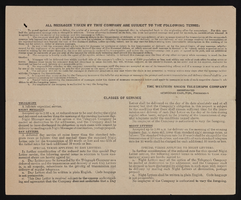Search the Special Collections and Archives Portal
Search Results
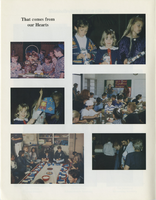
Member directory for Congregation Ner Tamid, 1990s
Date
Archival Collection
Description
The membership directory for Congregation Ner Tamid includes photographs of members and ongoing programs of the temple.
Text

Chelsie Campbell interview, January 9, 2019: transcript
Date
Archival Collection
Description
Chelsie Campbell is a Cuban-American attorney and lobbyist. Born on October 4, 1979, Chelsie is a native Nevadan and grew up in Las Vegas. Her mother, Norah Campbell, came to Las Vegas after the Cuban Revolution and works as an elementary school teacher. Her father, Alan Campbell, was a former teacher and hotel manager. An advocate for the Latino community, Chelsie has dedicated her life to advocacy. Her involvement began at UNLV where she found her voice through the Student Organization of Latinos (SOL). During her time with SOL, she advocated for the elimination of the social security requirement in UNLV’s admission process and lobbied for the retraction of Las Vegas Review Journal’s racist article on Latino students. Her activism in SOL also helped established additional SOL chapters across Las Vegas high schools and at the College of Southern Nevada. After earning her Bachelors in Broadcast Journalism and Spanish Literature from UNLV, Chelsie attended William S. Boyd Law School where she graduated in 2005. Chelsie also attended University of Nevada, Reno where she received her master’s in Management and a graduate certificate in renewable energy. Chelsie worked for Mach One Group as Editor-In-Chief of its two publications, Nevada Family Magazine and La Familia de Nevada. After law school, Chelsie began working at NV Energy as a spokesperson and worked her way up to government affairs. Chelsie is currently working as an independent lobbyist and choses her clients. Her clients include Clark County School District and NV Energy. Her work as a lobbyist includes helping agencies prepare for Nevada’s legislative session, conduct public policy research, and help with educational outreach. Through her activism, Chelsie has worked for former Senate Majority Leader, U.S. Senator Harry Reid. Chelsie is also part of the inaugural class of Emerge Nevada, a political leadership-training program for women in Nevada. Chelsie is on the Board of Trustees for the Leukemia and Lymphoma Society of Southern Nevada, the Chairwoman for the Nevada Advisory Board for CPLC Southwest, Board Member for the Advisory Commission on law-related Education for the State Bar of Nevada and serves on the Governmental Affairs Committee for the Latin Chamber of Commerce. She is the former President for the Boyd Law School Alumni Chapter and the Board of Directors for the Gray Plunkett Jydstrup Living Facility. Chelsie would like to dedicate her oral history to her parents: Without them, I wouldn’t be here.
Text
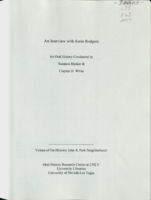
Transcript of interview with Kerin Scianna Rodgers by Suzanne Becker and Claytee D. White, February 7, 2009 and August 11 & 16, 2011
Date
Archival Collection
Description
Kerin Rodgers was born in 1936. She recounts her family history and stories of her youth growing up in Boston, MA, and shares how the family relocated to Seattle, WA in the mid-1940s. She talks about her enjoyment of theatrical arts and politics, and about being a resourceful divorced, single-mom and entrepreneur. In 1958 she opened a retail fashion store and modeling agency with a friend in Santa Monica, CA. Kerin had a knack for fashion and interior design that would assist her then and into the future. She also shares the story of arriving in Las Vegas as part of retail job with The Broadway stores in 1966—a two-week stint that seemed to have no ending. Her transition into Las Vegas included remarriage, a 1974 Keno win that enabled her to put down money on a home ( a house built by Paul Huffey) in the John S. Park neighborhood, and making close friends in the community. Her interview is sprinkled with tales of activities and personalities from the neighborhood's past and present. Kerin was involved with the Focus Youth House, speaks about First Fridays and art, as well as gives a perspective of police, criminal behaviors and changes in the neighborhood over the years. She hosted a local television show and enjoyed being a community activist.
Text
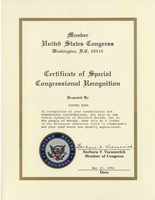
William Geagley Collection on Nuclear Safety
Identifier
Abstract
The William Geagley Collection on Nuclear Safety contains government publications, memoranda, and pamphlets about counteracting nuclear contamination of food supplies from 1951 to 1960. The materials primarily document Geagley’s oversight of the development of food safety contingency plans for the Michigan Department of Agriculture. The materials also contain information relating to the Nevada Test Site’s plans for Operation Plumbbob, atmospheric and underground nuclear tests held in 1957 in Nevada.
Archival Collection
Las Vegas Age
Alternate Title
Description
The Las Vegas Age was not Las Vegas's first newspaper; that distinction belongs to the short-lived Las Vegas Times which started publishing on March 25, 1905. But only two weeks later, on April 7, C.W. Nicklin founded what was the not-yet-a-city's third paper, the Age. Nicklin edited and published the Age from the Overland Hotel each Saturday as a six-page independent weekly, at $2 per year. When the railroad finally arrived, and laid out and auctioned off the town lots, the Age and its two competitors, the Times and the Advance, boomed with the new town amid lively journalistic debate. The Age briefly triumphed when the Times and Advance collapsed, until new competition arrived, and Nicklin left the Age to his partner Charles C. Corkhill to give his attention to his other paper, the Beatty Bullfrog Miner. Corkhill struggled for two years as editor and publisher, as Las Vegas languished in post-boom depression, then persuaded local businessman Charles P. "Pop" Squires to buy the paper, only after repeatedly dropping the price. Thus began the long and fruitful newspaper career of Charles Squires, sole editor and proprietor of the Age for almost forty years. Even after he sold the paper in 1943, he continued as editor until its last owner, Frank Garside of the Review-Journal, suspended publication of the Age on November 30, 1947.
As the Las Vegas Age, under Squires' shrewd editorship, dominated its local competition as the leading local newspaper with the largest circulation, it also became the leading paper in Southern Nevada. When Las Vegas was founded it was a remote railroad establishment far from the seat of Lincoln County, in Pioche where the county's leading newspaper and the paper of legal record was the Lincoln County Record, which had been in business since 1871. With the rapid growth of Las Vegas and the decline of the Pioche mining district, the population of southern Nevada shifted to the south and the divisions between the southern and northern sections of Lincoln County, which covered the whole of southeastern Nevada, became politically heated. When the Age began publication in Las Vegas in 1905, with a larger circulation than the Record in Pioche, the county commissioners decided to award to the Age all county printing and job work. The editor of the Record, not surprisingly, was enraged and commenced a series of personal attacks on the Age and the residents of Las Vegas, likening the Age to a mushroom fungi of uncertain life, possessing a readership of "floaters, the shiftless and reckless class."
Squires became the city's foremost booster and the Age became his trumpet, fighting for the division of Lincoln County that created Clark County, or for the new dam (an original member of Nevada's Colorado River Commission, Squires was in charge of publicity), or promoting as a one-man Chamber of Commerce civic and community organizations and projects or the city's nascent tourism and resort industry. Thus, the Age became the Voice of Las Vegas, as well as the most respected "paper of record" for the city. Other newspapers came and went, some were political adversaries (Squires was a staunch conservative, pro-business Republican), and some became well-established. But the Age remained the essential Las Vegas newspaper, from its fiercely independent editorials, to its boosterism and its comprehensive reporting of the simple everyday doings of this boisterous and dynamic new city.
See full information about this title online through Nevada's participation in the National Digital Newspaper Project. All issues digitized online at: Chronicling America collection from the Library of Congress.
1930
October
- Las Vegas Age, Vol. XXVI, No. 121 (1930-10-09)
- Las Vegas Age, Vol. XXVI, No. 122 (1930-10-11)
- Las Vegas Age, Vol. XXVI, No. 123 (1930-10-14)
- Las Vegas Age, Vol. XXVI, No. 124 (1930-10-16)
- Las Vegas Age, Vol. XXVI, No. 125 (1930-10-18)
- Las Vegas Age, Vol. XXVI, No. 126 (1930-10-21)
- Las Vegas Age, Vol. XXVI, No. 127 (1930-10-23)
- Las Vegas Age, Vol. XXVI, No. 128 (1930-10-25)
- Las Vegas Age, Vol. XXVI, No. 129 (1930-10-28)
- Las Vegas Age, Vol. XXVI, No. 130 (1930-10-30)
November
- Las Vegas Age, Vol. XXVI, No. 131 (1930-11-01)
- Las Vegas Age, Vol. XXVI, No. 132 (1930-11-04)
- Las Vegas Age, Vol. XXVI, No. 133 (1930-11-06)
- Las Vegas Age, Vol. XXVI, No. 134 (1930-11-08)
- Las Vegas Age, Vol. XXVI, No. 135 (1930-11-11)
- Las Vegas Age, Vol. XXVI, No. 136 (1930-11-13)
- Las Vegas Age, Vol. XXVI, No. 137 (1930-11-15)
- Las Vegas Age, Vol. XXVI, No. 138 (1930-11-18)
- Las Vegas Age, Vol. XXVI, No. 139 (1930-11-20)
- Las Vegas Age, Vol. XXVI, No. 140 (1930-11-22)
- Las Vegas Age, Vol. XXVI, No. 141 (1930-11-25)
- Las Vegas Age, Vol. XXVI, No. 142 (1930-11-27)
- Las Vegas Age, Vol. XXVI, No. 143 (1930-11-29)
December
- Las Vegas Age, Vol. XXVI, No. 144 (1930-12-02)
- Las Vegas Age, Vol. XXVI, No. 145 (1930-12-04)
- Las Vegas Age, Vol. XXVI, No. 146 (1930-12-06)
- Las Vegas Age, Vol. XXVI, No. 3 (1930-12-07)
- Las Vegas Age, Vol. XXVI, No. 147 (1930-12-09)
- Las Vegas Age, Vol. XXVI, No. 148 (1930-12-11)
- Las Vegas Age, Vol. XXVI, No. 149 (1930-12-13)
- Las Vegas Age, Vol. XXVI, No. 150 (1930-12-16)
- Las Vegas Age, Vol. XXVI, No. 151 (1930-12-18)
- Las Vegas Age, Vol. XXVI, No. 152 (1930-12-20)
- Las Vegas Age, Vol. XXVI, No. 153 (1930-12-23)
- Las Vegas Age, Vol. XXVI, No. 154 (1930-12-25)
- Las Vegas Age, Vol. 26, No. 155 (1930-12-27)
- Las Vegas Age, Vol. 26, No. 156 (1930-12-30)
1931
January
- Las Vegas Age, Vol. 27, No. 1 (1931-01-01)
- Las Vegas Age, Vol. 27, No. 2 (1931-01-03)
- Las Vegas Age, Vol. 27, No. 3 (1931-01-06)
- Las Vegas Age, Vol. 27, No. 4 (1931-01-08)
- Las Vegas Age, Vol. 27, No. 5 (1931-01-10)
- Las Vegas Age, Vol. 27, No. 6 (1931-01-13)
- Las Vegas Age, Vol. 27, No. 7 (1931-01-15)
- Las Vegas Age, Vol. 27, No. 8 (1931-01-17)
- Las Vegas Age, Vol. 27, No. 9 (1931-01-20)
- Las Vegas Age, Vol. 27, No. 10 (1931-01-22)
- Las Vegas Age, Vol. 27, No. 11 (1931-01-24)
- Las Vegas Age, Vol. 27, No. 12 (1931-01-27)
- Las Vegas Age, Vol. 27, No. 13 (1931-01-29)
- Las Vegas Age, Vol. 27, No. 14 (1931-01-31)
February
- Las Vegas Age, Vol. 27, No. 15 (1931-02-03)
- Las Vegas Age, Vol. 27, No. 16 (1931-02-05)
- Las Vegas Age, Vol. 27, No. 17 (1931-02-07)
- Las Vegas Age, Vol. 27, No. 18 (1931-02-10)
- Las Vegas Age, Vol. 27, No. 19 (1931-02-12)
- Las Vegas Age, Vol. 27, No. 20 (1931-02-14)
- Las Vegas Age, Vol. 27, No. 21 (1931-02-17)
- Las Vegas Age, Vol. 27, No. 22 (1931-02-19)
- Las Vegas Age, Vol. 27, No. 23 (1931-02-21)
- Las Vegas Age, Vol. 27, No. 24 (1931-02-24)
- Las Vegas Age, Vol. 27, No. 25 (1931-02-26)
- Las Vegas Age, Vol. 27, No. 26 (1931-02-28)
March
- Las Vegas Age, Vol. 27, No. 27 (1931-03-03)
- Las Vegas Age, Vol. 27, No. 28 (1931-03-05)
- Las Vegas Age, Vol. 27, No. 29 (1931-03-07)
- Las Vegas Age, Vol. 27, No. 30 (1931-03-10)
- Las Vegas Age, Vol. 27, No. 31 (1931-03-12)
- Las Vegas Age, Vol. 27, No. 32 (1931-03-14)
- Las Vegas Age, Vol. 27, No. 33 (1931-03-17)
- Las Vegas Age, Vol. 27, No. 34 (1931-03-19)
- Las Vegas Age, Vol. 27, No. 35 (1931-03-21)
- Las Vegas Age, Vol. 27, No. 36 (1931-03-24)
- Las Vegas Age, Vol. 27, No. 37 (1931-03-26)
- Las Vegas Age, Vol. 27, No. 38 (1931-03-28)
- Las Vegas Age, Vol. 27, No. 39 (1931-03-31)
April
- Las Vegas Age, Vol. 27, No. 40 (1931-04-02)
- Las Vegas Age, Vol. 27, No. 41 (1931-04-04)
- Las Vegas Age, Vol. 27, No. 42 (1931-04-07)
- Las Vegas Age, Vol. 27, No. 43 (1931-04-09)
- Las Vegas Age, Vol. 27, No. 44 (1931-04-11)
- Las Vegas Age, Vol. 27, No. 45 (1931-04-14)
- Las Vegas Age, Vol. 27, No. 46 (1931-04-16)
- Las Vegas Age, Vol. 27, No. 47 (1931-04-18)
- Las Vegas Age, Vol. 27, No. 48 (1931-04-21)
- Las Vegas Age, Vol. 27, No. 49 (1931-04-23)
- Las Vegas Age, Vol. 27, No. 50 (1931-04-25)
- Las Vegas Age, Vol. 27, No. 51 (1931-04-28)
- Las Vegas Age, Vol. 27, No. 52 (1931-04-30)
May
- Las Vegas Age, Vol. 27, No. 53 (1931-05-02)
- Las Vegas Age, Vol. 27, No. 54 (1931-05-05)
- Las Vegas Age, Vol. 27, No. 55 (1931-05-06)
- Las Vegas Age, Vol. 27, No. 56 (1931-05-07)
- Las Vegas Age, Vol. 27, No. 57 (1931-05-08)
- Las Vegas Age, Vol. 27, No. 58 (1931-05-09)
- Las Vegas Age, Vol. 27, No. 59 (1931-05-10)
- Las Vegas Age, Vol. 27, No. 60 (1931-05-12)
- Las Vegas Age, Vol. 27, No. 61 (1931-05-13)
- Las Vegas Age, Vol. 27, No. 62 (1931-05-14)
- Las Vegas Age, Vol. 27, No. 63 (1931-05-15)
- Las Vegas Age, Vol. 27, No. 64 (1931-05-16)
- Las Vegas Age, Vol. 27, No. 65 (1931-05-17)
- Las Vegas Age, Vol. 27, No. 66 (1931-05-19)
- Las Vegas Age, Vol. 27, No. 67 (1931-05-20)
- Las Vegas Age, Vol. 27, No. 68 (1931-05-21)
- Las Vegas Age, Vol. 27, No. 69 (1931-05-22)
- Las Vegas Age, Vol. 27, No. 70 (1931-05-23)
- Las Vegas Age, Vol. 27, No. 71 (1931-05-24)
- Las Vegas Age, Vol. 27, No. 72 (1931-05-26)
- Las Vegas Age, Vol. 27, No. 73 (1931-05-27)
- Las Vegas Age, Vol. 27, No. 74 (1931-05-28)
- Las Vegas Age, Vol. 27, No. 75 (1931-05-29)
- Las Vegas Age, Vol. 27, No. 76 (1931-05-30)
- Las Vegas Age, Vol. 27, No. 77 (1931-05-31)
June
- Las Vegas Age, Vol. 27, No. 78 (1931-06-02)
- Las Vegas Age, Vol. 27, No. 79 (1931-06-03)
- Las Vegas Age, Vol. 27, No. 80 (1931-06-04)
- Las Vegas Age, Vol. 27, No. 81 (1931-06-05)
- Las Vegas Age, Vol. 27, No. 82 (1931-06-06)
- Las Vegas Age, Vol. 27, No. 83 (1931-06-07)
- Las Vegas Age, Vol. 27, No. 84 (1931-06-09)
- Las Vegas Age, Vol. 27, No. 85 (1931-06-10)
- Las Vegas Age, Vol. 27, No. 85 (1931-06-11)
- Las Vegas Age, Vol. 27, No. 87 (1931-06-12)
- Las Vegas Age, Vol. 27, No. 88 (1931-06-13)
- Las Vegas Age, Vol. XXVII, No. 89 (1931-06-14)
- Las Vegas Age, Vol. 27, No. 90 (1931-06-16)
- Las Vegas Age, Vol. 27, No. 91 (1931-06-17)
- Las Vegas Age, Vol. 27, No. 92 (1931-06-18)
- Las Vegas Age, Vol. 27, No. 93 (1931-06-19)
- Las Vegas Age, Vol. 27, No. 94 (1931-06-20)
- Las Vegas Age, Vol. XXVII, No. 95 (1931-06-21)
- Las Vegas Age, Vol. 27, No. 96 (1931-06-23)
- Las Vegas Age, Vol. 27, No. 97 (1931-06-24)
- Las Vegas Age, Vol. 27, No. 98 (1931-06-25)
- Las Vegas Age, Vol. 27, No. 99 (1931-06-26)
- Las Vegas Age, Vol. 27, No. 100 (1931-06-27)
- Las Vegas Age, Vol. 27, No. 101 (1931-06-28)
- Las Vegas Age, Vol. 27, No. 102 (1931-06-30)
July
- Las Vegas Age, Vol. 27, No. 103 (1931-07-01)
- Las Vegas Age, Vol. 27, No. 104 (1931-07-02)
- Las Vegas Age, Vol. XXVII, No. 105 (1931-07-03)
- Las Vegas Age, Vol. XXVII, No. 106 (1931-07-04)
- Las Vegas Age, Vol. XXVII, No. 107 (1931-07-05)
- Las Vegas Age, Vol. XXVII, No. 108 (1931-07-07)
- Las Vegas Age, Vol. XXVII, No. 109 (1931-07-08)
- Las Vegas Age, Vol. XXVII, No. 110 (1931-07-09)
- Las Vegas Age, Vol. XXVII, No. 111 (1931-07-10)
- Las Vegas Age, Vol. XXVII, No. 112 (1931-07-11)
- Las Vegas Age, Vol. XXVII, No. 113 (1931-07-12)
- Las Vegas Age, Vol. XXVII, No. 114 (1931-07-14)
- Las Vegas Age, Vol. XXVII, No. 115 (1931-07-15)
- Las Vegas Age, Vol. XXVII, No. 116 (1931-07-16)
- Las Vegas Age, Vol. XXVII, No. 117 (1931-07-17)
- Las Vegas Age, Vol. XXVII, No. 118 (1931-07-18)
- Las Vegas Age, Vol. XXVII, No. 119 (1931-07-19)
- Las Vegas Age, Vol. XXVII, No. 120 (1931-07-21)
- Las Vegas Age, Vol. XXVII, No. 121 (1931-07-22)
- Las Vegas Age, Vol. XXVII, No. 122 (1931-07-23)
- Las Vegas Age, Vol. XXVII, No. 123 (1931-07-24)
- Las Vegas Age, Vol. XXVII, No. 124 (1931-07-25)
- Las Vegas Age, Vol. XXVII, No. 125 (1931-07-26)
- Las Vegas Age, Vol. XXVII, No. 126 (1931-07-28)
- Las Vegas Age, Vol. XXVII, No. 127 (1931-07-29)
- Las Vegas Age, Vol. XXVII, No. 128 (1931-07-30)
- Las Vegas Age, Vol. XXVII, No. 129 (1931-07-31)
August
- Las Vegas Age, Vol. XXVII, No. 130 (1931-08-01)
- Las Vegas Age, Vol. XXVII, No. 131 (1931-08-02)
- Las Vegas Age, Vol. XXVII, No. 132 (1931-08-04)
- Las Vegas Age, Vol. XXVII, No. 133 (1931-08-05)
- Las Vegas Age, Vol. XXVII, No. 134 (1931-08-06)
- Las Vegas Age, Vol. XXVII, No. 135 (1931-08-07)
- Las Vegas Age, Vol. XXVII, No. 136 (1931-08-08)
- Las Vegas Age, Vol. XXVII, No. 137 (1931-08-09)
- Las Vegas Age, Vol. XXVII, No. 138 (1931-08-11)
- Las Vegas Age, Vol. XXVII, No. 139 (1931-08-12)
- Las Vegas Age, Vol. XXVII, No. 140 (1931-08-13)
- Las Vegas Age, Vol. XXVII, No. 141 (1931-08-14)
- Las Vegas Age, Vol. XXVII, No. 142 (1931-08-15)
- Las Vegas Age, Vol. XXVII, No. 143 (1931-08-16)
- Las Vegas Age, Vol. XXVII, No. 144 (1931-08-18)
- Las Vegas Age, Vol. XXVII, No. 145 (1931-08-19)
- Las Vegas Age, Vol. XXVII, No. 146 (1931-08-20)
- Las Vegas Age, Vol. XXVII, No. 147 (1931-08-21)
- Las Vegas Age, Vol. XXVII, No. 148 (1931-08-22)
- Las Vegas Age, Vol. XXVII, No. 149 (1931-08-23)
- Las Vegas Age, Vol. XXVII, No. 150 (1931-08-25)
- Las Vegas Age, Vol. XXVII, No. 151 (1931-08-26)
- Las Vegas Age, Vol. XXVII, No. 152 (1931-08-27)
- Las Vegas Age, Vol. XXVII, No. 153 (1931-08-28)
- Las Vegas Age, Vol. XXVII, No. 154 (1931-08-29)
- Las Vegas Age, Vol. XXVII, No. 155 (1931-08-30)
September
- Las Vegas Age, Vol. XXVII, No. 156 (1931-09-01)
- Las Vegas Age, Vol. XXVII, No. 157 (1931-09-02)
- Las Vegas Age, Vol. XXVII, No. 158 (1931-09-03)
- Las Vegas Age, Vol. XXVII, No. 159 (1931-09-04)
- Las Vegas Age, Vol. XXVII, No. 160 (1931-09-05)
- Las Vegas Age, Vol. XXVII, No. 161 (1931-09-06)
- Las Vegas Age, Vol. XXVII, No. 162 (1931-09-08)
- Las Vegas Age, Vol. XXVII, No. 163 (1931-09-09)
Language
English
Frequency
Place of Publication
Geographic Coverage
International Standard Serial Number (ISSN)
Library of Congress Control Number (lccn)
OCLC Number
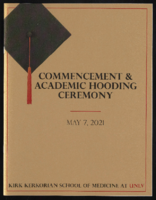
Kirk Kerkorian School of Medicine at UNLV 1st Commencement and Academic Hooding Ceremony
Date
Archival Collection
Description
Commencement program from University of Nevada, Las Vegas Commencement Programs and Graduation Lists (UA-00115).
Text
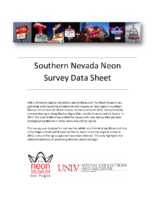
Poker Palace Neon Survey document, August 23, 2017
Date
Archival Collection
Description
Site address: 2757 N Las Vegas Blvd
Sign owner: Marvin and Laura Coleman
Sign details: This location opened 1974 with a castle theme. This location is also claimed as a locals casino. In 2015 their main pylon roadside sign caught on fire, but it was recently replaced.
Sign condition: 4- the signs that were not in the fire are still in relatively good condition
Sign form: Two pylons and architectural sign
Sign-specific description: The building itself has many different neon signs on it mostly red neon. Also the buildings architecture matches the palace theme. There are two pylon signs the first one states "Poker Palace Bingo" in channeled neon letters, then below is a reader board. The second pylon is just north a little of the first one, this is the one that caught on fire in 2015. After the fire the beam bases of the sign remained. This sign has "Poker Palace Casino" in red channeled letters.
Sign - type of display: Neon and incandescent
Sign - media: Steel and plastic
Sign - non-neon treatments: Reader board
Sign animation: Flasher for incandescent light bulbs.
Sign environment: This is located in North Las Vegas in a residential area and by a few other small businesses.
Sign - date of installation: Late 2015/ early 2016 for new pylon sign, others look to be older
Sign - date of redesign/move: 2015 pylon sign went up in flames and was destroyed, then replaced
Sign - thematic influences: The building looks like a palace which goes with their names and theme. Also their signs showcases similar shapes to the building.
Survey - research locations: Poker Palace website http://pokerpalace.net/History.html , Images of sign , Review Journal article https://www.reviewjournal.com/local/local-las-vegas/nlv-casino-marquee-fire-sends-up-plume-visible-for-miles/
Surveyor: Wyatt Currie-Diamond
Survey - date completed: 2017-08-23
Sign keywords: Architectural; Neon; Incandescent; Steel; Plastic; Flashing; Reader board; Pylon; Fascia
Text

